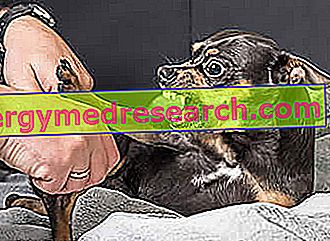Anger
The most formidable danger following a dog bite injury is the transmission of the ANGER. The virus responsible for this disease is in fact transmitted through saliva, with an incubation period ranging from 20 days to one year (on average from one to three months).

- ASPECIFIC PRODROMIC PHASE: it lasts 1-4 days and is characterized by fever, headache, malaise, anorexia, fatigue, dry throat, irritated cough, tingling at the site of inoculation, vomiting and diarrhea.
- PHASE OF THE ENSAFALITE: crisis of motor hyperactivity, agitation, confusion, hallucinations, signs of meningitis. Hypersensitivity to noise and light.
- PHASE OF CEREBRAL TRUNK DYSFUNCTION: cranial nerve deficiency with diplopia ("double" vision), facial paralysis and swallowing disorders: hydrophobia (refusal to drink, failure to swallow saliva that gives foam to the mouth). Death due to respiratory failure. For this reason, the drool at the mouth of the dog that caused the accident is an important alarm bell that, together with its aggressiveness, should make us suspect a possible angry state.
Remember that rabies can also be transmitted by the bite of other animals (such as the fox, the monkey, the cat and the wolf) or by simple contact with their saliva (licking on wounds or abrasions). It must be said, however, that in Italy anger is absolutely not widespread among domestic animals; the rare episodes that have occurred in recent years have concerned above all the wild foxes that populate the northern regions, bordering Austria, Switzerland and Slovenia. For this reason, when you go on holiday with your dog in these places, it is good to subject it to rabies vaccination in advance.
What to do?
Anger aside, when being bitten by a dog it is necessary to keep in mind that in the animal's mouth bacteria and fermented food residues are present which, entering the wound, can cause serious infections, up to gangrene.
If the patient is not vaccinated or has doubts about it, tetanus prophylaxis is useful, since the type of lesion strongly increases the risk of infection with anaerobes (tetanus).
After being bitten by a dog it is therefore important to immediately and abundantly wash the wound with a soapy solution, rinse and disinfect (even when the wound is mild or small). Hydrogen peroxide is useful, to be used generously for the aforementioned risk of infection with anaerobes (bacteria that live in the absence of oxygen).
Invite the patient to contact the competent Hygiene office to verify the health status of the dog that bit it (even when the wound is mild or moderate).
If the animal is suspect and it is not possible to keep it under observation in the days following the bite, rabies vaccine prophylaxis is indicated, which allows, given the long incubation of the disease, the establishment of an effective immune response before the virus attacks the nervous system central.
Prevent bites and assaults
The chronicle reports, unfortunately more and more frequently, episodes of serious aggression, sometimes with fatal results, by combat-trained dogs. If you find yourself in a similar situation, before attacking the dog, if you have the time, it is essential to remain calm. It is forbidden to run away, unless, of course, one thinks of reaching a safe spot before the eventual attack. In any case, the best thing to do is keep calm, stop, possibly sideways and not in front of the dog (to expose a minor body surface to the possible attack), but always keeping a watchful eye on it and keeping ready to protect the neck and face; no shouting. Keeping a cool head, it is likely that the dog stops its run a few inches from you, aiming and continuing to bark angrily. Do not worry, the more it is done, keep looking at it, but don't make any sudden movements or any other gesture to try to intimidate it; probably after a few minutes, recalled by the owner or spontaneously he will slowly back away. At this point, you can move away as cautiously, without running and never turning your back on the animal.
It must be said, in any case, that these situations are rather rare and that more often than not the dogs bite because we have given them a good reason to do so. Therefore, especially if the animal is not known, it is good to follow some rules: avoid invading its territory, especially in the absence of the owner; do not pet it without having the explicit consent of the guardian and great attention to small children, often dogs, even the most docile, bite them out of jealousy or fear (the child is often clumsy with the animal, or tends to scream and to frighten him).
The main rule to follow to prevent dog bites is therefore not to be frightened or frightened.



